Demographic and Cultural Drivers of Space-use in White-faced Capuchins
Social groups are subject to demographic processes (e.g., immigration, emigration, births and deaths) that cause groups to form, grow, shrink and ultimately disappear. They can also split (fission) and merge (fusion), in response to social and environmental pressures. Changes in group structure and membership shape the social relationships within groups and between neighbors. They may also serve as pathways for introducing new information about the environment. The central goal of my research is to use long-term data of white-faced capuchin monkeys (Cebus capucinus) to investigate the role demography and cultural transmission play in shaping space-use patterns of group-living animals.
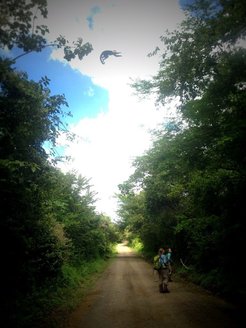
Movement and space-use are central to the lives of animals, impacting how they encounter resources and avoid predators. Therefore, studying animal space-use is critical to understanding species persistence and developing sound practices for management and conservation. Many animals restrict their space-use to confined areas that they are familiar with, called home ranges. The size, stability, and location of home ranges are shaped by several factors, including the abundance of resources in the environment, metabolic requirements of the animals, competition between individuals and groups, predation risk, and spatial information. Over time, as environmental and social conditions change, the sizes and shapes of home ranges can change as well.
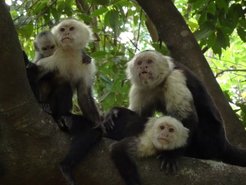
(photo credit: Luz Maria Guevara)
Demographic factors likely play an under-appreciated role in shaping animals’ space-use, especially in long-lived animals, because many years (even decades!) of data are required to identify and understand demographic trends. For this reason, the relationship between demographic processes and group-level outcomes remains poorly understood. The gain and loss of individuals through births, deaths, immigration, and emigration should have an important role in shaping space use because these processes change important characteristics of the group that affect movement patterns. These characteristics include: group-level energetic requirements, competition between groups, and the “collective intelligence” of the group. My PhD research aims to understand the role these processes play on home range behavior using a 30-year data-set from the Lomas Barbudal Monkey Project in Costa Rica.
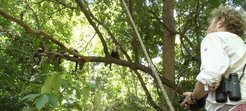
The Lomas Barbudal Monkey Project
My PhD research will focus on a population of habituated white-faced capuchins living within the Lomas Barbudal Biological Reserve in Guanacaste, Costa Rica. The project is run by Prof. Dr. Susan Perry of University of California, Los Angeles (UCLA) who started the project with one group of capuchins to investigate their life history and social intelligence. Before data collection began in 1990, the first step was habituation. This was the slow process of following the monkeys as they gradually became indifferent to the presence of human observers, which took around six months for the first group. Later on, the habituation of more groups became possible with the help of a larger field team. Over time, the permanent fissioning of groups caused the number of study groups to increase further. Today, thirteen groups are monitored, with behavioral data collection focusing on seven main study groups. By censusing the individuals within all these groups over time, demographic patterns (i.e. identities of births, deaths, migrations) are recorded. The scope of the Lomas Barbudal Monkey Project in terms of tracking long-term demographic change, and monitoring a large number of social groups, presents a unique opportunity to investigate the social drivers of space-use in group-living animals.
Measuring Space-use from Sleep Site Locations
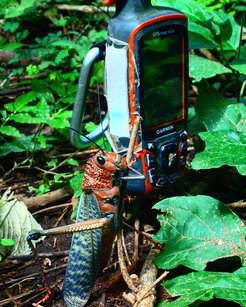
While sleep site data is far lower in resolution than GPS tracking data, it does provide a much longer temporal scope for my project. This is because GPS tracking is a relatively new procedure, while sleep site locations have been recorded since the very beginning of the project. So far, these data have only served to relocate the monkeys and have not been used for other purposes. Nevertheless, sleep sites may be an exceedingly valuable tool to understand how these social groups used the landscape over a long time scale, including the period before GPS tracking began.
Therefore, one of the primary objectives of my PhD will be to determine the utility of using sleep site locations for estimating home ranges. By comparing sleep site estimates with track estimates from the most recent decade, it will better inform us how we can use the historical sleep site data from before the GPS technology was introduced. This will not only lay the groundwork for the rest of my thesis, but it may also provide novel methodology for other long-term projects.

Group Size and Home Range Area
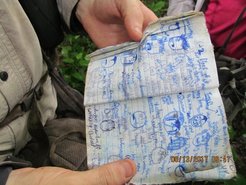
To begin to understand how sociality and demography affect space-use, I will investigate how group size impacts the area of home ranges. Home range area tends to increase with group size. This is because collective energetic requirements increase with more group members, necessitating farther travel distances each day and larger home ranges to find enough resources. Group size also influences the competitive ability of groups, determining whether they can exclude neighboring groups from important resources. Smaller, weaker groups may have smaller home ranges, if their movements are constrained by larger, more dominant neighbors. Alternately, smaller groups may have larger home ranges than expected if they are forced into resource-poor areas by larger groups. This is because they may need to travel farther each day in order to find enough resources to compensate for the energetic cost of foraging in less productive areas.
My goal is to disentangle these variables to determine the most important drivers of home range area for the capuchin groups at Lomas Barbudal. Several studies have examined the relationship between group size and home range area by comparing between groups of different sizes in a snap-shot in time. However, the dataset at Lomas Barbudal provides a unique opportunity to compare how the home ranges of any one group develop over the long-term, as demographic changes influence the number of individuals in the group over time.
Immigration, Information, and Ranging ‘Cultures’
Immigration may be a source of novel information about the environment, allowing groups to expand their spatial horizons and discover new resources on the landscape. Dispersal in white-faced capuchins is typically male-biased, and occurs when individuals emigrate from the group where they were born (i.e. natal dispersal) in efforts to find another group in which to immigrate and reproduce. Often males will switch groups several additional times (i.e. secondary dispersal) throughout their lives to further their chances of reproduction. This has clear implications on the spread of genetic information between groups, however immigration may also be an important vector of environmental information, transmitting culturally through social learning.
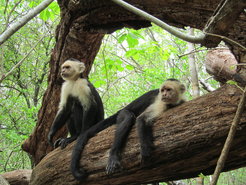
Having relevant information about one’s surroundings is critical for survival. When animals travel outside of familiar areas, they become more susceptible to predation and starvation. Despite this, animals may move into new areas if they acquire novel information about travel routes and resource locations. I am interested in investigating whether immigrants are a source of this information, and whether cultural transmission is a key factor shaping group home ranges. If immigrants expand their new group’s spatial limits, I expect that the arrival of new group members to coincide with home range shifts and the uncovering of new resources on the landscape.
Permanent Group Fission
Another force of major demographic change is group-splitting. When capuchin groups become too large, competition and conflict can drive a portion of the group to bud off and form a separate “new” group. These fissions are discrete and rare events, but are nonetheless important because capuchin groups almost never fuse back together, and therefore have life-long effects on social networks and kin relationships. These fissions have rarely been observed, let alone studied, and therefore it is unclear how these events affect the ranging behavior of the newly formed groups. For example, does one group tend to remain in the natal home range while the other is ostracized to unfamiliar terrain? If so, what determines which group stays and which group goes? And for the group that is forced to leave, what are the important factors influencing where they establish a new home range?
The questions I plan to address in my PhD research have important implications for how group-living animals use the space on the landscape as groups change in their size and composition over time. Investigating these processes will be crucial for understanding the social and evolutionary drivers of space-use, and will likely provide conservation biologists with useful information for protecting critical habitat of group-living species.
Further reading & Cited articles
Crofoot, M. C., I. C. Gilby, M. C. Wikelski, and R. W. Kays. 2008. “Interaction Location Outweighs the Competitive Advantage of Numerical Superiority in Cebus Capucinus Intergroup Contests.” Proceedings of the National Academy of Sciences 105(2): 577–81.
Crofoot, Margaret C. 2013. “The Cost of Defeat: Capuchin Groups Travel Further, Faster and Later after Losing Conflicts with Neighbors: Defeated Capuchin Groups Travel Further, Faster, Later.” American Journal of Physical Anthropology 152(1): 79–85.
Janmaat, Karline R. L. et al. 2009. “Long-Term Site Fidelity and Individual Home Range Shifts in Lophocebus Albigena.” International Journal of Primatology 30(3): 443–66.
Janmaat, Karline R L. 2021. “Using Natural Travel Paths to Infer and Compare Primate Cognition in the Wild.” OPEN ACCESS: 17.
Joo, Rocio et al. 2020. A Decade of Movement Ecology.
Perry, Susan. 2012. “Chapter 4 - The Behavior of Wild White-Faced Capuchins: Demography, Life History, Social Relationships, and Communication.” In Advances in the Study of Behavior, eds. H. Jane Brockmann et al. Academic Press, 135–81. http://www.sciencedirect.com/science/article/pii/B9780123942883000046 (November 10, 2020).
Perry, Susan, Irene Godoy, and Wiebke Lammers. 2012. “The Lomas Barbudal Monkey Project: Two Decades of Research on Cebus Capucinus.” In Long-Term Field Studies of Primates, , 141–63.
Seiler, Nicole, and Martha M. Robbins. 2020. “Using Long-Term Ranging Patterns to Assess within-Group and between-Group Competition in Wild Mountain Gorillas.” BMC Ecology 20(1): 40.
Learn more about white-face capuchins and the Lomas Barbudal Monkey Project
Family Trees
Tracking Capuchin monkeys in Costa Rica: A 25 year study in Lomas Barbudal
Written by Odd Jacobson, Department for the Ecology of Animal Societies








